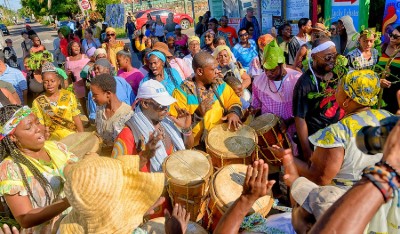Our True Culture in the Caribbean, Our Greatest Treasure
As tourism stakeholders increasingly recognize the need to promote authentic cultural offerings, I cannot help but recall the masterpiece entitled “Culture” by the distinguished Barbadian calypsonian and cultural ambassador Mighty Gabby.
 Hopkins Village is considered by some to be the cultural center of the Garifuna population in Belize.In the classic, Gabby bemoaned the declining state of cultural awareness in the Caribbean: “All of this talk 'bout culture driving me mad, I taking it hard. How dem expect to have culture plan for Caribbean man from North America? We got to start here at home, then we'll no longer roam.”
Hopkins Village is considered by some to be the cultural center of the Garifuna population in Belize.In the classic, Gabby bemoaned the declining state of cultural awareness in the Caribbean: “All of this talk 'bout culture driving me mad, I taking it hard. How dem expect to have culture plan for Caribbean man from North America? We got to start here at home, then we'll no longer roam.”
“Cultural archeology” is a term used to describe the reviving of little-known or largely forgotten cultural practices and traditions. It helps communities uncover valuable troves of their heritage by revisiting overlooked parts of their cultures and environment and serves to enrich the destination’s heritage while inspiring younger generations to embrace and honor the elements of culture that have shaped the present.
Today, the Caribbean would benefit from greater connectivity between the hotels and resorts that house our visitors and the communities in which they are embedded to design and implement authentic, responsible, unique, captivating cultural activities that can be experienced by visitors and residents alike. Non-governmental organizations (NGOs) and culture bearers should be essential partners in these endeavors.
Local NGOs often have valuable and influential relationships with their regional and international counterparts, connections that can provide additional expertise, funding, and can share best practices in achieving agreed-upon goals.
International donors embed the participation of NGOs in projects aimed at benefiting communities because they understand that while government and large organizations can make blocks of resources available to nations, they need the reach of NGOs to ensure community outreach. As an expert noted: “Governments and large international companies are like the fists carrying resources into countries – but NGOs are the fingers which reach into areas not accessible to large fists.”
Community groups can engage with culture bearers, like Gabby, who can help uncover songs, chants, and traditions which may have withered from disuse in a changing modern world. In this way, cultural archeology not only revives a destination’s heritage and traditions, but also ignites interest among the younger generations who can breathe new life into them and carry them forward. This results in precisely the sort of experience today’s travelers are seeking.
When it comes to ecological conservation and regeneration of fragile foreshores, for example, NGOs can talk to elders who recount how certain ocean currents, which refreshed coral reefs and fish stocks, were diverted by non-sustainable shoreline construction, damaging coral and diminishing fish stocks.
Our guardians of indigenous knowledge also understand the priceless value of our natural resources and diverse environments. They are often in the best position to share knowledge that advances the conservation of fragile ecosystems and to provide insight that ensures visits through our lands and waters do not degrade the environment. This is the sort of information which could take scientists years to discover yet can be uncovered quickly by learning from people who have lived in the area their entire lives and who retain the indigenous knowledge of their ancestors.
Cultural archeology can, therefore, be a means for tourism stakeholders to work responsibly with NGOs and communities to unearth cultural assets, enrich cultural heritage, and enhance cultural value to modern travelers seeking authenticity.
There are many examples of Caribbean destinations that are taking concrete steps towards not only preserving their unique, irreplaceable culture and history, but also are investing in programs and initiatives to ensure that the alluring, captivating elements that draw visitors to our shores are also promoted in culturally sensitive and authentic ways. But I daresay, we need more. Much more.
As Gabby croons, “I mean box cart and stick for wicket, mauby and marble cricket, slamming domino in competition, calypso and sweet sweet steel band, so now you see what I really mean, this is my true culture in the Caribbean.”


